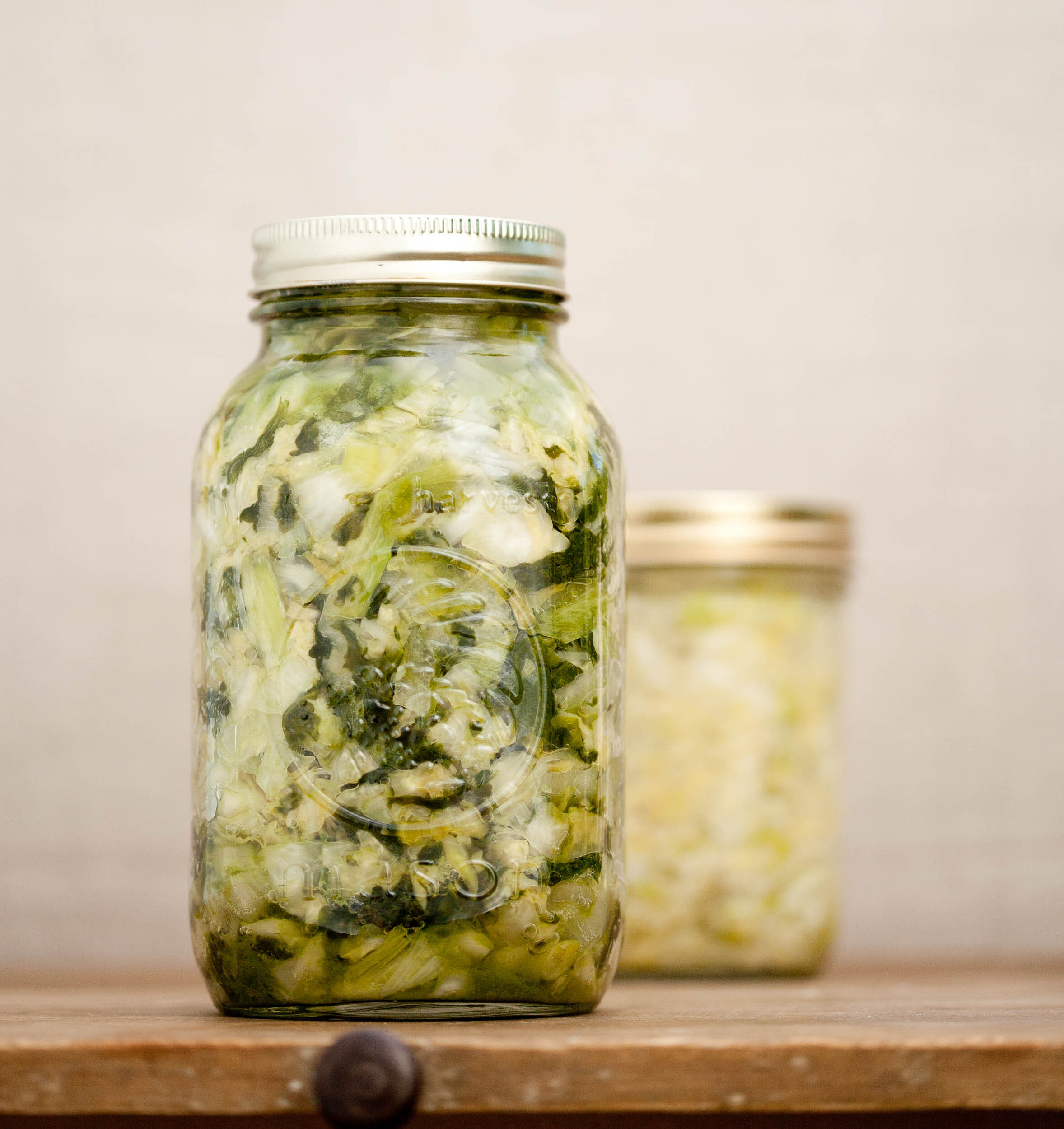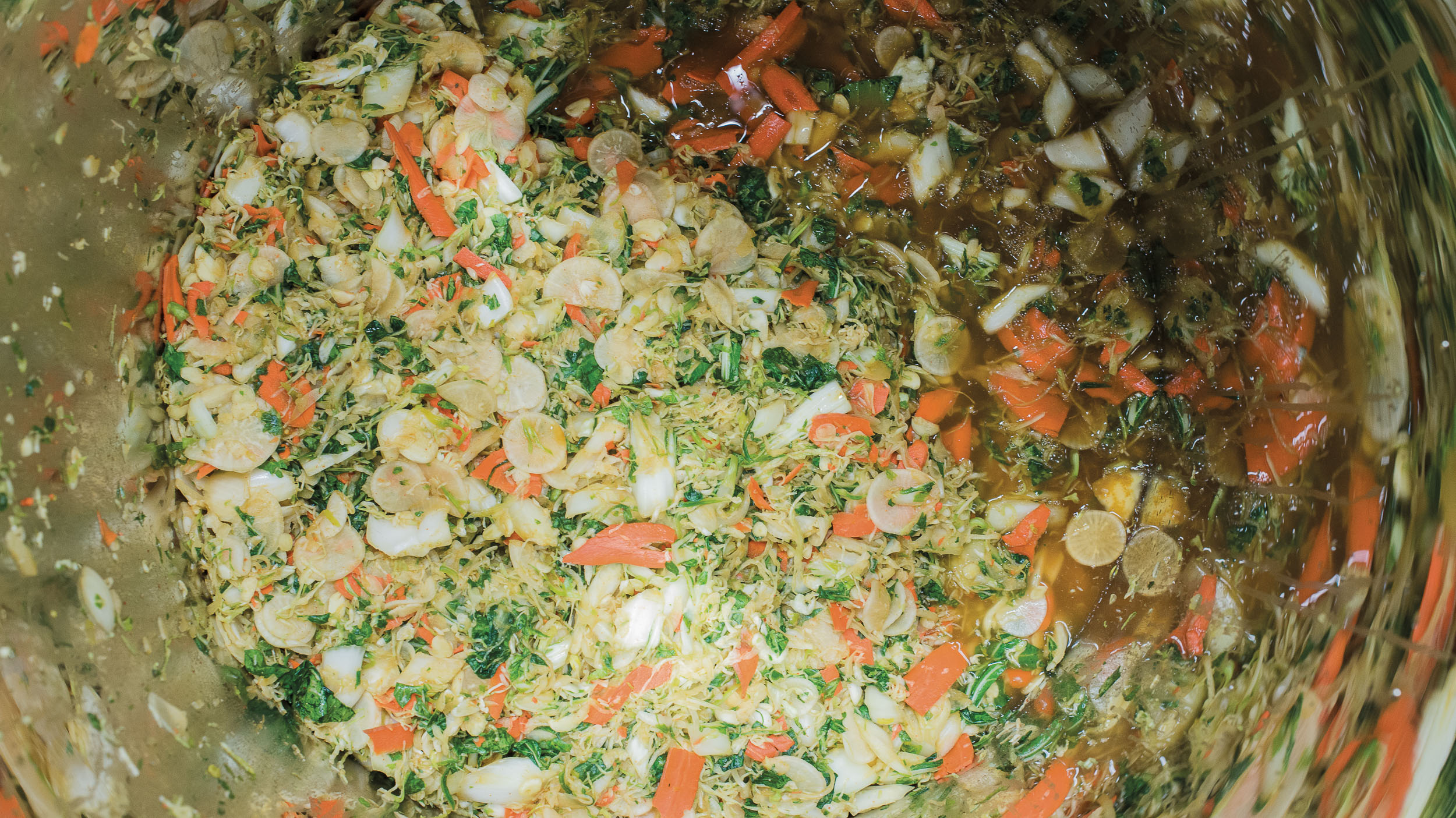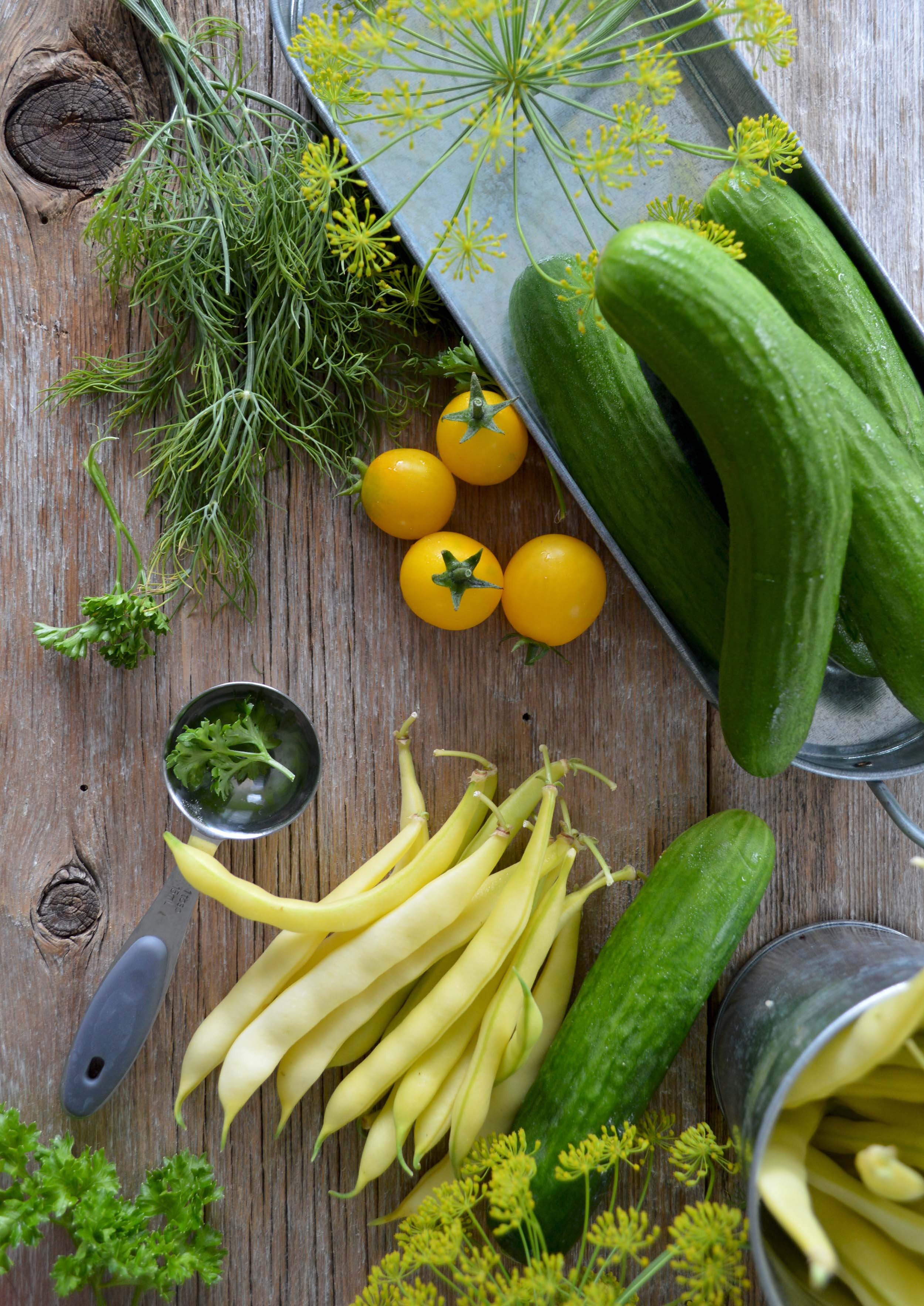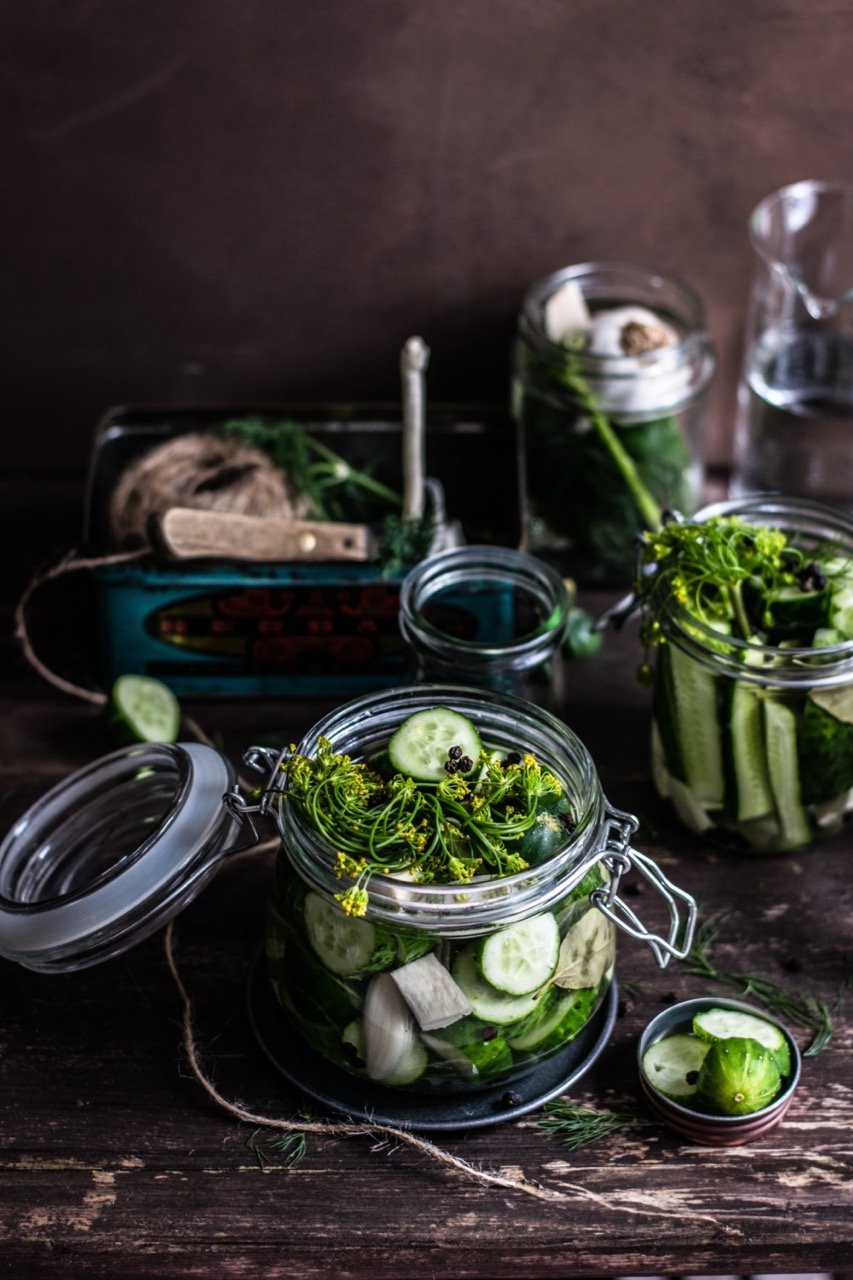The Alchemy of Sauerkraut

Fermenting Good Health
How did we ever survive before the onset of refrigeration, pasteurization, and preservatives? Each fall, our forebears would set about preserving vegetables using the age-old craft of fermentation. Over the long winter months, their pickled, nutrient-packed vegetables kept them nourished and healthy.
One of the most traditional of lactic acid-fermented vegetables is sauerkraut, German for "sour herb." Though associated with German cuisine, sauerkraut originated in China around 220 B.C. when laborers building the Great Wall were fed a diet of nutritious and long-lasting fermented cabbage.
Cabbage itself is exceedingly nutritious, high in calcium (1 cup of shredded cabbage contains as much calcium as 8 glasses of fresh cow milk) and vitamin C (more than in an orange). With no fat and packed with fiber, cabbage is touted for treating inflammation, lowering cholesterol, and fighting disease.
When foods are fermented (i.e., broken down into simpler components), their natural nutritional value is not only retained but increased as the process' active cultures generate nutrients. Fermented sauerkraut is full of fiber, low in calories, and a source of vitamins C and K, calcium, potassium, and iron. Because fermentation doesn't use heat, the process retains beneficial digestive enzymes, lactic acid bacteria, vitamins, and other nutrients that food processing would destroy.
Sauerkraut is rich in lactobacilli (lactic-acid-producing bacteria), which work with the good bacteria in your stomach to help with digestion and nutrient absorption.
Probiotics, the live and active cultures found in sauerkraut, act to prevent disease and aid in treating it. The cultures not only help with stomach, kidney, and liver function, but studies have shown that fermented cabbage has increased levels of anti-cancer agents such as isothiocyanates. These can be an immune system booster and can help control inflammation, a precursor to many diseases and cancers.
Increasingly, sauerkraut diets are recommended after accidents and loss of blood because fermented sauerkraut, containing the compound choline, improves and balances the composition of blood and provides it with nutritious substances. Sauerkraut also has an effect on the nervous system, dropping blood pressure, lowering the heart rate, and improving sleep patterns. The presence in sauerkraut of choline, dubbed the "bowel movement hormone," makes the vegetable a natural remedy for constipation.
Fermented products are most beneficial when eaten in moderate portions and regularly. Like a proverbial apple, sauerkraut should be snacked on daily.
A HEALTHY HISTORY
The first written instructions on lactic acid fermentation were found in the 50 A.D. writings of Roman scholar Pliny. The Romans were steadfast eaters of sauerkraut and other fermented products.
In the 13th century, Mongolians are thought to have introduced fermented cabbage into Europe, beginning in Eastern Europe (such staples as the Polish kiszona kapusta and the Czech kysane zeli) and later spreading throughout Western Europe.
In the 18th century, sauerkraut, with its high vitamin C content, was known as an effective cure for scurvy and thus became a favorite with sea travelers, including Captain James Cook. German sailors are said to have continued eating sauerkraut even after the British Royal Navy switched its medicinal leaning to limes -- hence the origin of the slang terms "Kraut" and "Limey," respectively, for German and British sailors.
HOW FERMENTATION WORKS
Author Sandor Elixx Katz, a self-proclaimed "fermentation fetishist," asserts that the key to successful vegetable fermentation is to make sure your vegetables are submerged in liquid (usually salty water or "brine").
Salt pulls water from the vegetables and hardens pectins in them, making them crunchier. It also discourages the growth of bacteria other than the beneficial lactobacilli, which enables the vegetables to be stored for longer periods. More salt slows the fermentation process, less speeds it up. Katz recommends beginning with three tablespoons of salt per five pounds of vegetables, adjusting the salt to taste.
Herbs and spices can be added to enhance flavor and provide minerals and trace elements. Fermented sauerkraut utilizes caraway seeds, juniper berries, apples, or cranberries. Kimchi uses red chili peppers, garlic, ginger, and scallions. Sour pickles are spiced with dill, garlic, and sometimes hot peppers. Other possible herbs to add are yellow mustard, horseradish, onions, tarragon, savory, pimento, cloves, bay leaves, raspberry leaves, and coriander.
Place the food in a vessel in a cool spot with minimal oxygen such as a basement or a root cellar. (Koreans traditionally place their kimchi pots in the ground at a consistent temperature of 55 degrees.) Heavy ceramic cylindrical crocks or glass containers work well.
The vegetables must be packed into the vessel with force (you can use a tamping tool or even a fist) to keep out the air, break down cell walls, and release juices. Employing the "open crock method," Katz fits a plate inside the vessel, weighing it down with a full jug of water, and drapes a cloth over the top to protect against flies.
The salt will continue to pull moisture from the vegetables. If the vegetables are not submerged by the next day, add water.
Lacto-fermentation is considered successful when the vegetables remain preserved over weeks or months of cold storage. A pleasing aroma and pleasant, slightly sour taste should result, with the amount of tanginess increasing with time.
Some experts say that sauerkraut needs six months to fully mature, though others suggest it can be eaten immediately after the initial fermentation. Katz advises tasting ferments early and often. "Serve some after three days, then three days later, and again three days after that," he says. "Familiarize yourself with the spectrum of flavors that fermentation can create and see what you like."
OTHER FERMENTED VEGETABLES – FAR & NEAR
Almost any vegetable - whether shredded, chopped, or whole - can be fermented. Popular choices include broccoli, cauliflower, kale, kohlrabi, beans, cucumbers, onions, Brussel sprouts, radishes, celery, tomatoes, peppers, leeks, rutabaga, and turnips.
In addition to preserving foods, fermentation creates extraordinary flavors. Kimchi, sauerkraut's spicy Korean cousin, appears at every Korean meal either as a condiment or a main ingredient of soups, hot pots, stir-fries, dumplings, and rice dishes.
Kimchi is fermented napa cabbage often mixed with daikon radish, tomatoes, and cucumbers. Many consider kimchi to have the greatest benefits of all fermented vegetables: helping prevent constipation and colon cancer; reducing serum cholesterol; and ameliorating stress, depression, osteoarthritis, liver disease, obesity, and atherosclerosis.
Nuoc mam is a popular fermented fish sauce (often made from anchovies) from Vietnam and Thailand and is rich in vitamins A and D and iodine.
In Japan, miso is a paste resulting from fermenting soybeans, rice, and barley. Packed with vitamins and minerals, miso is used for sauces and spreads and is mixed with dashi soup stock to make miso soup, a Japanese culinary staple.
In China, suan cai is pickled cabbage, and douchi is made from fermented soybeans and is known to lower blood pressure.
Kvass (deriving from the Slavonic word for "acid") is the collective name for a lactic acid-fermented drink·originating in Russia and Poland. It is made from apples, pears, berries, and root plants mixed with flour and sauerkraut or its juice.
CHOOSING REAL FERMENTED SAUERKRAUT
When you buy sauerkraut, read the label carefully. Store-bought sauerkraut can be filled with chemicals that mimic the fermentation process without any of the benefits. Real fermented sauerkraut is made from cabbage, water, and salt (no vinegar should be listed on the label).
Raw artisan sauerkraut has many advantages over commercial sauerkraut:
Crunchiness
Contains active enzymes and live probiotics
Can inhibit e-coli, candida, and other pathogenic·organisms
Uses organic vegetables
Contains only natural organic acids — no vinegar
FERMENTED VEGETABLES EMBRACED BY CINCINNATIANS
A growing number of Greater Cincinnati health care professionals are endorsing eating raw fermented foods, among them acupuncturist Esly Caldwell III. Caldwell recommends kimchi and other organic, non-pasteurized foods to many of his patients for immune support, particularly during cold and flu season. "A growing body of evidence shows that having healthy gut bacteria, a benefit of fermented foods, strengthens the immune system and helps to ward off the common cold," he observes.
Caldwell is a supporter of Fab Ferments, local producers of kimchi, krauts, kvass, and kombucha (fermented tea). Jordan Aversman, one of its co-founders, clarifies the differences between fermenting, pickling, and canning — terms which are often confused with each other.
"Fermentation is a subcategory of pickling," he explains. "They both refer to the preservation of food in an anaerobic environment, resulting in the production of beneficial bacteria."
Unlike pickling, canning requires the food to be completely cooked before being jarred and sealed, then going through a hot water bath where it is heated once more, rendering the live cultures sterile.
"Naturally fermented foods are the healthiest way to preserve food," Aversman affirms. "The food is made more digestible and nutritious, and fermented food is credited with countless health benefits."
Although fermented foods have the dual benefits of promoting health and enabling us to naturally preserve food from seasons of plenty to use in periods of scarcity, consumption of fermented foods has declined globally. Traditional food systems have given way to the not-so-healthy influences of Western diets and food processing.
Consuming authentic fermented vegetables increases the demand for organic foods and helps support small farms.
Connie Springer is a writer, freelance photographer, and a Professional Archivist consultant. She has written for Hyde Park Living, Taste Magazine, and ESL Magazine. Find a list of current exhibits on her website.





